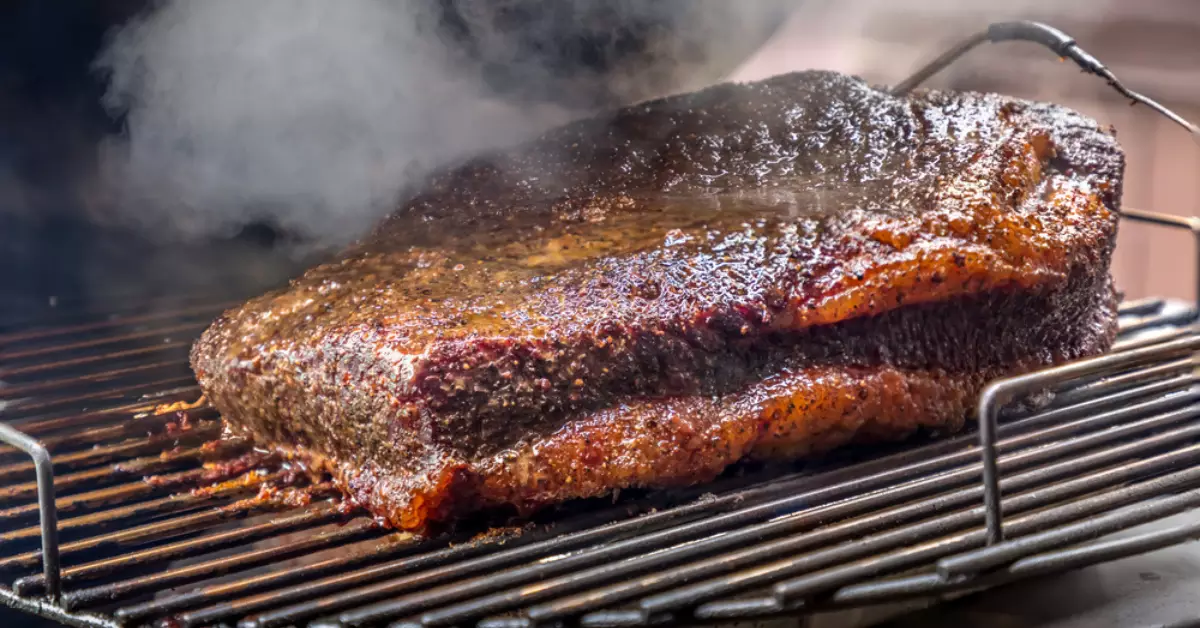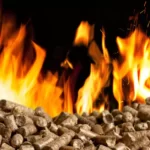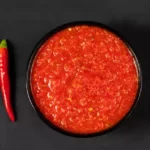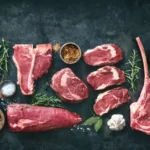Brisket, a cut of meat from the breast or lower chest of beef or veal, is a staple in many culinary traditions. This flavorful and hearty cut, with its rich marbling and fibrous texture, can transform into a succulent, tender meal when cooked properly. The key to unlocking the full potential of brisket lies largely in understanding the role of temperature in its cooking process.
In the realm of cooking brisket, temperature matters. While 165 degrees Fahrenheit is widely recognized as the safe minimum internal temperature for most meats, brisket poses a different scenario. Can you eat brisket at 165 degrees? Technically, yes. The meat is safe for consumption. However, if you’re aiming for that fall-apart tenderness synonymous with a well-cooked brisket, then this temperature falls short.
Brisket at 165 degrees can be a topic of debate among pitmasters and home cooks alike. This cut, known for its toughness, requires careful and slow cooking to break down the collagen and render it into gelatin. This process, crucial for achieving the desired tenderness, usually doesn’t occur fully at 165 degrees.
The Significance of 165 Degrees
165 Degrees: The Safety Threshold for Most Meats
The U.S. Department of Agriculture (USDA) recommends a minimum internal temperature of 165 degrees for poultry. This temperature guideline is designed to kill harmful bacteria, making the meat safe to eat. However, different types of meat have different recommended safe internal temperatures.
Why Brisket is Different
Brisket, being a tougher cut, requires a higher internal temperature to reach optimal tenderness. This temperature is usually above the standard 165 degrees used for many other meats.
The Science of Brisket at 165 Degrees
Brisket, unlike many other cuts of meat, has a unique composition that requires a nuanced approach to cooking. The complexity lies in its dense collagen content, which requires careful handling and specific temperature control to properly break down. This section aims to explain the transformation that occurs when brisket reaches 165 degrees and why it’s not quite the sweet spot for this particular cut.
Temperature and the Breakdown of Collagen
Brisket contains a large amount of collagen due to the nature of the muscles in this area of the animal. These muscles are heavily used and therefore develop a strong, fibrous network of collagen. This is what gives the brisket its characteristic toughness when raw.
When heated, collagen begins to denature – a process where the protein’s structure unravels and loses its original shape. Around 160 degrees Fahrenheit, the collagen starts to turn into gelatin, a process known as collagen hydrolysis.
This gelatin adds a moist, melt-in-your-mouth quality to the meat. However, at 165 degrees, this process has only just begun. To ensure most of the collagen has transformed into gelatin, achieving the coveted brisket tenderness, the internal temperature needs to reach somewhere between 195 and 205 degrees.
Effect of 165 Degrees on Flavor and Texture
While a brisket at 165 degrees is safe for consumption, it hasn’t fully achieved the tender, flavorful profile that is typically sought after. Here’s how the temperature impacts both the flavor and texture:
- Flavor: At 165 degrees, the brisket hasn’t had a chance to fully render its fat and break down its collagen. Both these processes contribute significantly to flavor, with fat adding juiciness and the gelatin imparted by collagen breakdown enriching the mouthfeel and taste. Therefore, stopping at 165 degrees may result in a brisket that’s less flavorful.
- Texture: The texture of the brisket at 165 degrees can be best described as chewy. The collagen hasn’t broken down sufficiently into gelatin, leaving the meat tough. It lacks the fall-apart tenderness associated with a properly cooked brisket.
Why Most Chefs Don’t Recommend 165 Degrees for Brisket
Achieving a perfectly tender, flavor-packed brisket is no small feat. It requires patience and a sound understanding of how temperature impacts this particular cut of meat. While 165 degrees marks the safety threshold, it falls short when it comes to delivering a great eating experience.
The Optimal Brisket Temperature: Expert Opinions
Ask any seasoned pitmaster or professional chef, and they’ll tell you that the sweet spot for brisket lies within the 195-205 degrees range. Here’s why:
- Collagen Breakdown: This temperature range ensures the complete transformation of tough collagen into rich, flavorful gelatin.
- Fat Rendering: The higher heat allows the brisket’s fat to render properly, basting the meat from the inside out and adding to its flavor and juiciness.
- Bark Formation: The prolonged cooking time needed to reach this temperature range helps form a robust bark – the crispy, flavorful crust that’s a prized feature of a well-smoked brisket.
Risks and Downsides of Eating Brisket at 165 Degrees
Choosing to eat brisket at 165 degrees comes with its own set of potential drawbacks:
- Tough Texture: The brisket may be safe to eat, but its texture will likely be tougher than desired.
- Less Flavor: At this temperature, the fat hasn’t had a chance to fully render, and the collagen-to-gelatin transformation is incomplete, resulting in a less flavorful brisket.
- Longer Chew Time: Due to the tougher texture, the meat may take longer to chew, affecting the overall eating experience.
Tips for Cooking Brisket to the Perfect Temperature
Cooking brisket to perfection is as much an art as it is a science. Understanding how to control your heat and knowing when your brisket has hit its optimal internal temperature can make all the difference. Here are some tips and steps to achieve the perfect brisket.
Equipment Needed for Precise Temperature Control
To cook a brisket properly, you need a few pieces of key equipment. These include:
- A Quality Smoker or Grill: This is where the magic happens. Look for a smoker or grill that maintains consistent temperatures and has good airflow.
- Reliable Meat Thermometer: This tool is vital to ensure your brisket reaches and maintains the correct internal temperature. Go for a digital one for accuracy.
- Aluminum Foil or Butcher Paper: You’ll need this to wrap your brisket once it hits the 165 degrees mark to prevent it from drying out as you continue cooking it to a higher internal temperature.
Steps for Achieving the Optimal Brisket Temperature
Here’s a step-by-step guide to help you cook your brisket to perfection:
- Preheat your smoker: Aim for a temperature of 225 degrees Fahrenheit. Consistent low heat is key to a tender brisket.
- Season your brisket: Use your favorite rub or keep it simple with a generous seasoning of salt and pepper.
- Smoke the brisket: Place it on the smoker or grill, fat side up.
- Monitor the internal temperature: Use a meat thermometer to keep track.
- Wrap the brisket: When it reaches an internal temperature of 165 degrees, it’s time to wrap the brisket in foil or butcher paper. This will help it retain moisture as it continues to cook.
- Continue cooking: Maintain the smoker temperature and continue cooking the brisket until it reaches an internal temperature between 195 and 205 degrees.
- Rest the brisket: Allow the brisket to rest for at least an hour before slicing. This allows the juices to redistribute throughout the meat, resulting in a moister brisket.
How to Safely Enjoy Brisket
Now that we’ve covered how to cook brisket to the perfect temperature, let’s look at how to safely handle and enjoy your brisket.
Safe Meat Handling and Cooking Practices
It’s essential to practice safe meat handling to prevent foodborne illnesses. Here are some basic tips:
- Always store your raw brisket at 40 degrees Fahrenheit or below.
- Defrost frozen brisket in the refrigerator, not on the countertop.
- Use separate cutting boards for raw and cooked foods to prevent cross-contamination.
- Always wash your hands thoroughly before and after handling raw meat.
- Clean all utensils and surfaces touched by raw meat with hot, soapy water.
Signs Your Brisket is Properly Cooked
A properly cooked brisket should be tender, with a dark crust (bark) on the outside and a pink smoke ring beneath the surface. The meat should easily pull apart and have a rich, deep flavor.
Frequently Asked Questions
How long should brisket cook at 165 degrees?
Brisket should not be cooked at a consistent 165 degrees as it would not allow for proper collagen breakdown. It should first reach 165 degrees, then be wrapped and cooked until it reaches the ideal temperature of 195-205 degrees.
Can I raise the temperature to cook brisket faster?
Raising the temperature might cook the brisket faster, but it can also result in a tougher, drier meat. Slow and low cooking is recommended for the best outcome.
What if my brisket is tough at 205 degrees?
If your brisket is tough even at 205 degrees, it might not have been cooked long enough. Temperature is important, but so is time. The collagen breakdown can take several hours, and some briskets may need a bit more time to become tender.
Conclusion
Brisket cooking is a delicate art that hinges heavily on temperature control. The question of eating brisket at 165 degrees leads to a culinary crossroad: safety vs. quality. It is safe to consume brisket at this temperature, but the culinary experience might be less than desired.
In practice, cooking brisket involves surpassing the safe minimum temperature of 165 degrees, aiming for an internal temperature that facilitates the complete breakdown of collagen. This approach leads to a tender, fall-apart brisket, embodying the celebrated flavors of this beloved dish.
Ultimately, the choice to consume brisket at 165 degrees rests on individual preference. Whether you prioritize speed and safety or tenderness and flavor can guide your decision. However, for a truly exceptional brisket experience, patience is key. Slow cooking at a controlled temperature reaps a flavorful, tender brisket, making the wait worthwhile.







